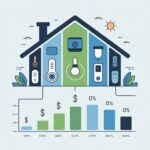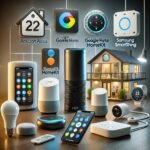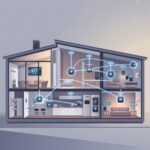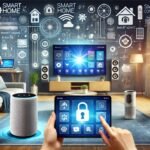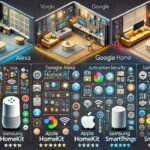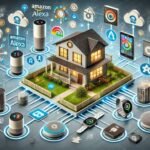What is a Smart Home?
Definition and Overview
A smart home, also known as a home automation system, is a residence equipped with interconnected devices and appliances that can be controlled remotely via the internet or a central control system.
These devices range from lights, thermostats, and security systems to entertainment units and kitchen appliances.
The primary goal of a smart home is to enhance convenience, efficiency, and security through automation and remote control.
Key Characteristics of a Smart Home:
- Interconnectivity: Devices and systems within the home are connected, often through a central hub or a network, enabling them to communicate and work together seamlessly.
- Automation: Tasks such as adjusting the thermostat, turning on lights, or locking doors can be automated based on predefined settings, schedules, or triggers.
- Remote Control: Homeowners can control and monitor their smart home devices remotely using smartphones, tablets, or voice assistants.
- Energy Efficiency: Smart homes can optimize energy usage, reducing waste and lowering utility bills through smart thermostats, lighting, and energy monitoring systems.
- Enhanced Security: Advanced security features include smart locks, surveillance cameras, and alarm systems that can be monitored and controlled remotely.
- Customization: Users can personalize their smart home settings to match their lifestyle, preferences, and needs.
History and Evolution of Smart Home Technology
Early Beginnings: The concept of home automation dates back to the early 20th century.
The development of electrical wiring in homes during the 1920s and 1930s laid the foundation for automation.
Simple devices like electric garage door openers and basic intercom systems were among the first automated home technologies.
1960s – 1970s: The Birth of Home Automation: In the 1960s, the first significant steps towards home automation were taken.
The “ECHO IV,” developed in 1966 by Jim Sutherland, is often considered the first true home automation device.
It could control temperature, appliances, and even compile shopping lists. However, it was never commercially sold.
In the 1970s, the X10 protocol was introduced, becoming the first widely adopted home automation standard.
X10 allowed electronic devices to communicate with each other over the existing electrical wiring in homes.
This era also saw the development of early home security systems and the introduction of programmable thermostats.
1980s – 1990s: Advancements and Challenges: The 1980s and 1990s witnessed significant advancements in home automation technology.
The introduction of personal computers and advancements in microprocessor technology enabled more sophisticated control systems.
Companies like Honeywell and IBM began developing home automation products, including early smart thermostats and integrated security systems.
However, these early systems faced challenges. High costs, complexity, and lack of standardization limited widespread adoption.
Interoperability issues between different devices and systems were common, and installation often required professional expertise.
2000s: The Rise of the Internet and Wireless Technology: The early 2000s marked a turning point for smart home technology with the rise of the internet and wireless communication.
Wi-Fi, Bluetooth, and other wireless technologies allowed for more flexible and user-friendly home automation solutions.
The development of smartphones and mobile apps provided a new way to control and monitor smart home devices remotely.
Companies like Nest (acquired by Google) and SmartThings (acquired by Samsung) emerged, offering user-friendly smart thermostats and home automation hubs.
These products were designed for easy installation and use, making smart home technology more accessible to the average consumer.
2010s: Mainstream Adoption and Integration: The 2010s saw smart home technology move from early adopters to mainstream consumers.
Voice assistants like Amazon Alexa, Google Assistant, and Apple Siri played a significant role in this shift.
These voice-controlled platforms allowed users to interact with their smart home devices more naturally and intuitively.
During this decade, major tech companies entered the smart home market, offering a wide range of interconnected devices.
Products like smart speakers, lights, security cameras, and appliances became more affordable and widely available.
The integration of artificial intelligence (AI) and machine learning enabled smarter, more adaptive home automation systems.
2020s and Beyond: The Future of Smart Homes: As we move into the 2020s, smart home technology continues to evolve rapidly.
Key trends shaping the future of smart homes include:
- Increased Interoperability: Efforts like the Matter initiative aim to create a universal standard for smart home devices, ensuring seamless compatibility across different brands and platforms.
- Enhanced AI and Machine Learning: Smarter AI algorithms will enable more predictive and personalized automation, learning users’ habits and preferences over time.
- Health and Wellness Integration: Smart home devices are increasingly focusing on health and wellness, with features like air quality monitoring, sleep tracking, and fitness integration.
- Sustainability: Smart homes are becoming more eco-friendly, with technologies that optimize energy usage, reduce waste, and integrate with renewable energy sources.
- Advanced Security: Continued advancements in biometric authentication, facial recognition, and cybersecurity will enhance the security and privacy of smart homes.
- IoT Expansion: The Internet of Things (IoT) will expand further, connecting more devices and enabling new use cases for home automation.
The journey of smart home technology from its early beginnings to the sophisticated systems of today showcases the tremendous advancements in automation, connectivity, and user experience. A smart home offers unparalleled convenience, efficiency, and security, transforming the way we live and interact with our living spaces. As technology continues to evolve, smart homes will become even more integrated, intuitive, and essential to our daily lives.



